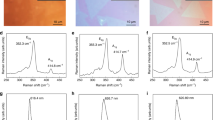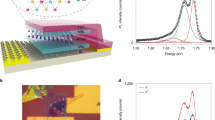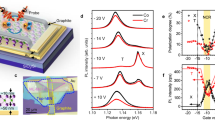Abstract
Exploiting the valley degree of freedom to store and manipulate information provides a novel paradigm for future electronics. A monolayer transition-metal dichalcogenide (TMDC) with a broken inversion symmetry possesses two degenerate yet inequivalent valleys1,2, which offers unique opportunities for valley control through the helicity of light3,4,5. Lifting the valley degeneracy by Zeeman splitting has been demonstrated recently, which may enable valley control by a magnetic field6,7,8,9. However, the realized valley splitting is modest (∼0.2 meV T–1). Here we show greatly enhanced valley spitting in monolayer WSe2, utilizing the interfacial magnetic exchange field (MEF) from a ferromagnetic EuS substrate. A valley splitting of 2.5 meV is demonstrated at 1 T by magnetoreflectance measurements and corresponds to an effective exchange field of ∼12 T. Moreover, the splitting follows the magnetization of EuS, a hallmark of the MEF. Utilizing the MEF of a magnetic insulator can induce magnetic order and valley and spin polarization in TMDCs, which may enable valleytronic and quantum-computing applications10,11,12.
This is a preview of subscription content, access via your institution
Access options
Access Nature and 54 other Nature Portfolio journals
Get Nature+, our best-value online-access subscription
$29.99 / 30 days
cancel any time
Subscribe to this journal
Receive 12 print issues and online access
$259.00 per year
only $21.58 per issue
Buy this article
- Purchase on Springer Link
- Instant access to full article PDF
Prices may be subject to local taxes which are calculated during checkout




Similar content being viewed by others
References
Xiao, D., Liu, G.-B., Feng, W., Xu, X. & Yao, W. Coupled spin and valley physics in monolayers of MoS2 and other group-VI dichalcogenides. Phys. Rev. Lett. 108, 196802 (2012).
Zhu, Z., Cheng, Y. & Schwingenschlögl, U. Giant spin-orbit-induced spin splitting in two-dimensional transition-metal dichalcogenide semiconductors. Phys. Rev. B 84, 153402 (2011).
Cao, T. et al. Valley-selective circular dichroism of monolayer molybdenum disulphide. Nat. Commun. 3, 887 (2012).
Mak, K. F., He, K., Shan, J. & Heinz, T. F. Control of valley polarization in monolayer MoS2 by optical helicity. Nat. Nanotechnol. 7, 494–498 (2012).
Zeng, H. L., Dai, J. F., Yao, W., Xiao, D. & Cui, X. D. Valley polarization in MoS2 monolayers by optical pumping. Nat. Nanotechnol. 7, 490–493 (2012).
Li, Y. et al. Valley splitting and polarization by the Zeeman effect in monolayer MoSe2 . Phys. Rev. Lett. 113, 266804 (2014).
Aivazian, G. et al. Magnetic control of valley pseudospin in monolayer WSe2 . Nat. Phys. 11, 148–152 (2015).
MacNeill, D. et al. Breaking of valley degeneracy by magnetic field in monolayer MoSe2 . Phys. Rev. Lett. 114, 037401 (2015).
Srivastava, A. et al. Valley Zeeman effect in elementary optical excitations of monolayer WSe2 . Nat. Phys. 11, 141–147 (2015).
Zhang, Q. Y., Yang, S. Y. A., Mi, W. B., Cheng, Y. C. & Schwingenschlögl, U. Large spin-valley polarization in monolayer MoTe2 on top of EuO(111). Adv. Mater. 28, 959–966 (2016).
Qi, J. S., Li, X., Niu, Q. & Feng, J. Giant and tunable valley degeneracy splitting in MoTe2 . Phys. Rev. B 92, 121403 (2015).
Rohling, N., Russ, M. & Burkard, G. Hybrid spin and valley quantum computing with singlet-triplet qubits. Phys. Rev. Lett. 113, 176801 (2014).
Matte, H. S. et al. MoS2 and WS2 analogues of graphene. Angew. Chem. Int. Ed. 49, 4059–4062 (2010).
Zhao, W. et al. Evolution of electronic structure in atomically thin sheets of WS2 and WSe2 . ACS Nano 7, 791–797 (2013).
Yuan, H. T. et al. Generation and electric control of spin-valley-coupled circular photogalvanic current in WSe2 . Nat. Nanotechnol. 9, 851–857 (2014).
Eginligil, M. et al. Dichroic spin-valley photocurrent in monolayer molybdenum disulphide. Nat. Commun. 6, 7636 (2015).
Lee, J., Mak, K. F. & Shan, J. Electrical control of the valley Hall effect in bilayer MoS2 transistors. Nat. Nanotechnol. 11, 421–425 (2016).
Mak, K. F., McGill, K. L., Park, J. & McEuen, P. L. The valley Hall effect in MoS2 transistors. Science 344, 1489–1492 (2014).
Scrace, T. et al. Magnetoluminescence and valley polarized state of a two-dimensional electron gas in WS2 monolayers. Nat. Nanotechnol. 10, 603–607 (2015).
Yuan, H. T. et al. Zeeman-type spin splitting controlled by an electric field. Nat. Phys. 9, 563–569 (2013).
Ye, Y. et al. Electrical generation and control of the valley carriers in a monolayer transition metal dichalcogenide. Nat. Nanotechnol. 11, 598–602 (2016).
Stier, A. V., McCreary, K. M., Jonker, B. T., Kono, J. & Crooker, S. A. Exciton diamagnetic shifts and valley Zeeman effects in monolayer WS2 and MoS2 to 65 Tesla. Nat. Commun. 7, 10643 (2016).
Koperski, M. et al. Single photon emitters in exfoliated WSe2 structures. Nat. Nanotechnol. 10, 503–506 (2015).
Sie, E. J. et al. Valley-selective optical Stark effect in monolayer WS2 . Nat. Mater. 14, 290–294 (2015).
Kim, J. et al. Ultrafast generation of pseudo-magnetic field for valley excitons in WSe2 monolayers. Science 346, 1205–1208 (2014).
Moodera, J. S., Santos, T. S. & Nagahama, T. The phenomena of spin-filter tunnelling. J. Phys-Condens. Mat. 19, 165202 (2007).
Korenev, V. Optical orientation in ferromagnet/semiconductor hybrids. Semiconductor Sci. Technol. 23, 114012 (2008).
Wei, P. et al. Strong interfacial exchange field in the graphene/EuS heterostructure. Nat. Mater. 15, 711–716 (2016).
Wang, Z., Tang, C., Sachs, R., Barlas, Y. & Shi, J. Proximity-induced ferromagnetism in graphene revealed by the anomalous Hall effect. Phys. Rev. Lett. 114, 016603 (2015).
Katmis, F. et al. A high-temperature ferromagnetic topological insulating phase by proximity coupling. Nature 533, 513–516 (2016).
Lazic, P., Belashchenko, K. D. & Zutic, I. Effective gating and tunable magnetic proximity effects in two-dimensional heterostructure. Phys. Rev. B 93, 241401 (2016).
He, K. L. et al. Tightly bound excitons in monolayer WSe2 . Phys. Rev. Lett. 113, 026803 (2014).
Li, C. H. et al. Spin injection across (110) interfaces: Fe/GaAs(110) spin-light-emitting diodes. Appl. Phys. Lett. 85, 1544–1546 (2004).
Taheri, P. et al. Growth mechanism of largescale MoS2 monolayer by sulfurization of MoO3 film. Mater. Res. Express 3, 075009 (2016).
Gurarslan, A. et al. Surface-energy-assisted perfect transfer of centimeter-scale monolayer and few-layer MoS2 films onto arbitrary substrates. ACS Nano 8, 11522–11528 (2014).
Acknowledgements
This work was supported by US National Science Foundation (MRI-1229208, DMR-1104994 and CBET-1510121), the Natural Sciences and Engineering Research Council of Canada Discovery grant RGPIN 418415-2012, the National Natural Science Foundation of China (nos 11504169, and 61575094) and the Unity Through Knowledge Fund, Contract No. 22/15. We thank Q. Niu, X. Li (University of Texas at Austin) and I. Zutic (University of Buffalo) for the insightful discussions.
Author information
Authors and Affiliations
Contributions
H.Z. and A.P. conceived and designed experiments. C.Z., P.-Q.Z., P.T., K.K. and J.W. prepared and characterized the monolayer TMDCs, including WSe2, and transferred them onto EuS substrates. P.Z., T.N., C.Z., T.S. and A.P. performed magneto-optical measurements and data analysis. Y.Y. and G.M. provided the EuS thin films. F.S. performed magnetic measurements of EuS. R.S. and Y.C. performed the first-principle calculations. H.Z., C.Z., Y.C., R.S. G.K. and A.P. wrote the manuscript. All the authors commented on the manuscript.
Corresponding author
Ethics declarations
Competing interests
The authors declare no competing financial interests.
Supplementary information
Supplementary information
Supplementary information (PDF 605 kb)
Rights and permissions
About this article
Cite this article
Zhao, C., Norden, T., Zhang, P. et al. Enhanced valley splitting in monolayer WSe2 due to magnetic exchange field. Nature Nanotech 12, 757–762 (2017). https://doi.org/10.1038/nnano.2017.68
Received:
Accepted:
Published:
Issue Date:
DOI: https://doi.org/10.1038/nnano.2017.68
This article is cited by
-
Proposal for valleytronic materials: Ferrovalley metal and valley gapless semiconductor
Frontiers of Physics (2024)
-
Epitaxial substitution of metal iodides for low-temperature growth of two-dimensional metal chalcogenides
Nature Nanotechnology (2023)
-
Ferromagnetism emerged from non-ferromagnetic atomic crystals
Nature Communications (2023)
-
Photonic van der Waals integration from 2D materials to 3D nanomembranes
Nature Reviews Materials (2023)
-
Proximity-induced chiral quantum light generation in strain-engineered WSe2/NiPS3 heterostructures
Nature Materials (2023)



